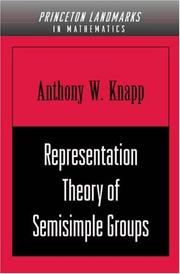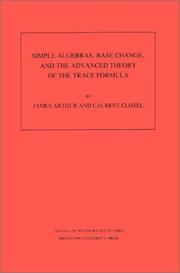| Listing 1 - 3 of 3 |
Sort by
|

ISBN: 0691090890 9780691090894 0691084017 1400883970 9780691084015 Year: 1986 Volume: 36 Publisher: Princeton, N.J.
Abstract | Keywords | Export | Availability | Bookmark
 Loading...
Loading...Choose an application
- Reference Manager
- EndNote
- RefWorks (Direct export to RefWorks)
In this classic work, Anthony W. Knapp offers a survey of representation theory of semisimple Lie groups in a way that reflects the spirit of the subject and corresponds to the natural learning process. This book is a model of exposition and an invaluable resource for both graduate students and researchers. Although theorems are always stated precisely, many illustrative examples or classes of examples are given. To support this unique approach, the author includes for the reader a useful 300-item bibliography and an extensive section of notes.
Semisimple Lie groups. --- Representations of groups. --- Groupes de Lie semi-simples --- Représentations de groupes --- Semisimple Lie groups --- Representations of groups --- Semi-simple Lie groups --- Lie groups --- Group representation (Mathematics) --- Groups, Representation theory of --- Group theory --- Représentations de groupes --- 512.547 --- 512.547 Linear representations of abstract groups. Group characters --- Linear representations of abstract groups. Group characters --- Abelian group. --- Admissible representation. --- Algebra homomorphism. --- Analytic function. --- Analytic proof. --- Associative algebra. --- Asymptotic expansion. --- Automorphic form. --- Automorphism. --- Bounded operator. --- Bounded set (topological vector space). --- Cartan subalgebra. --- Cartan subgroup. --- Category theory. --- Characterization (mathematics). --- Classification theorem. --- Cohomology. --- Complex conjugate representation. --- Complexification (Lie group). --- Complexification. --- Conjugate transpose. --- Continuous function (set theory). --- Degenerate bilinear form. --- Diagram (category theory). --- Dimension (vector space). --- Dirac operator. --- Discrete series representation. --- Distribution (mathematics). --- Eigenfunction. --- Eigenvalues and eigenvectors. --- Existence theorem. --- Explicit formulae (L-function). --- Fourier inversion theorem. --- General linear group. --- Group homomorphism. --- Haar measure. --- Heine–Borel theorem. --- Hermitian matrix. --- Hilbert space. --- Holomorphic function. --- Hyperbolic function. --- Identity (mathematics). --- Induced representation. --- Infinitesimal character. --- Integration by parts. --- Invariant subspace. --- Invertible matrix. --- Irreducible representation. --- Jacobian matrix and determinant. --- K-finite. --- Levi decomposition. --- Lie algebra. --- Locally integrable function. --- Mathematical induction. --- Matrix coefficient. --- Matrix group. --- Maximal compact subgroup. --- Meromorphic function. --- Metric space. --- Nilpotent Lie algebra. --- Norm (mathematics). --- Parity (mathematics). --- Plancherel theorem. --- Projection (linear algebra). --- Quantifier (logic). --- Reductive group. --- Representation of a Lie group. --- Representation theory. --- Schwartz space. --- Semisimple Lie algebra. --- Set (mathematics). --- Sign (mathematics). --- Solvable Lie algebra. --- Special case. --- Special linear group. --- Special unitary group. --- Subgroup. --- Summation. --- Support (mathematics). --- Symmetric algebra. --- Symmetrization. --- Symplectic group. --- Tensor algebra. --- Tensor product. --- Theorem. --- Topological group. --- Topological space. --- Topological vector space. --- Unitary group. --- Unitary matrix. --- Unitary representation. --- Universal enveloping algebra. --- Variable (mathematics). --- Vector bundle. --- Weight (representation theory). --- Weyl character formula. --- Weyl group. --- Weyl's theorem. --- ZPP (complexity). --- Zorn's lemma.

ISBN: 0691085188 069108517X 1400882400 Year: 1989 Volume: vol 120 Publisher: Princeton University Press
Abstract | Keywords | Export | Availability | Bookmark
 Loading...
Loading...Choose an application
- Reference Manager
- EndNote
- RefWorks (Direct export to RefWorks)
A general principle, discovered by Robert Langlands and named by him the "functoriality principle," predicts relations between automorphic forms on arithmetic subgroups of different reductive groups. Langlands functoriality relates the eigenvalues of Hecke operators acting on the automorphic forms on two groups (or the local factors of the "automorphic representations" generated by them). In the few instances where such relations have been probed, they have led to deep arithmetic consequences. This book studies one of the simplest general problems in the theory, that of relating automorphic forms on arithmetic subgroups of GL(n,E) and GL(n,F) when E/F is a cyclic extension of number fields. (This is known as the base change problem for GL(n).) The problem is attacked and solved by means of the trace formula. The book relies on deep and technical results obtained by several authors during the last twenty years. It could not serve as an introduction to them, but, by giving complete references to the published literature, the authors have made the work useful to a reader who does not know all the aspects of the theory of automorphic forms.
511.33 --- Analytical and multiplicative number theory. Asymptotics. Sieves etc. --- 511.33 Analytical and multiplicative number theory. Asymptotics. Sieves etc. --- Automorfe vormen --- Automorphic forms --- Formes automorphes --- Representation des groupes --- Representations of groups --- Trace formulas --- Vertegenwoordiging van groepen --- Formulas, Trace --- Discontinuous groups --- Group representation (Mathematics) --- Groups, Representation theory of --- Group theory --- Automorphic functions --- Forms (Mathematics) --- Analytical and multiplicative number theory. Asymptotics. Sieves etc --- Representations of groups. --- Trace formulas. --- Automorphic forms. --- 0E. --- Addition. --- Admissible representation. --- Algebraic group. --- Algebraic number field. --- Approximation. --- Archimedean property. --- Automorphic form. --- Automorphism. --- Base change. --- Big O notation. --- Binomial coefficient. --- Canonical map. --- Cartan subalgebra. --- Cartan subgroup. --- Central simple algebra. --- Characteristic polynomial. --- Closure (mathematics). --- Combination. --- Computation. --- Conjecture. --- Conjugacy class. --- Connected component (graph theory). --- Continuous function. --- Contradiction. --- Corollary. --- Counting. --- Coxeter element. --- Cusp form. --- Cyclic permutation. --- Dense set. --- Density theorem. --- Determinant. --- Diagram (category theory). --- Discrete series representation. --- Discrete spectrum. --- Division algebra. --- Eigenvalues and eigenvectors. --- Eisenstein series. --- Exact sequence. --- Existential quantification. --- Field extension. --- Finite group. --- Finite set. --- Fourier transform. --- Functor. --- Fundamental lemma (Langlands program). --- Galois extension. --- Galois group. --- Global field. --- Grothendieck group. --- Group representation. --- Haar measure. --- Harmonic analysis. --- Hecke algebra. --- Hilbert's Theorem 90. --- Identity component. --- Induced representation. --- Infinite product. --- Infinitesimal character. --- Invariant measure. --- Irreducibility (mathematics). --- Irreducible representation. --- L-function. --- Langlands classification. --- Laurent series. --- Lie algebra. --- Lie group. --- Linear algebraic group. --- Local field. --- Mathematical induction. --- Maximal compact subgroup. --- Multiplicative group. --- Nilpotent group. --- Orbital integral. --- P-adic number. --- Paley–Wiener theorem. --- Parameter. --- Parametrization. --- Permutation. --- Poisson summation formula. --- Real number. --- Reciprocal lattice. --- Reductive group. --- Root of unity. --- Scientific notation. --- Semidirect product. --- Special case. --- Spherical harmonics. --- Subgroup. --- Subset. --- Summation. --- Support (mathematics). --- Tensor product. --- Theorem. --- Trace formula. --- Unitary representation. --- Weil group. --- Weyl group. --- Zero of a function.
Book
ISBN: 0691082464 069161136X 1400871131 069163937X 9780691082462 Year: 1979 Publisher: Princeton (N.J.): Princeton university press
Abstract | Keywords | Export | Availability | Bookmark
 Loading...
Loading...Choose an application
- Reference Manager
- EndNote
- RefWorks (Direct export to RefWorks)
Based on a series of lectures given by Harish-Chandra at the Institute for Advanced Study in 1971-1973, this book provides an introduction to the theory of harmonic analysis on reductive p-adic groups.Originally published in 1979.The Princeton Legacy Library uses the latest print-on-demand technology to again make available previously out-of-print books from the distinguished backlist of Princeton University Press. These editions preserve the original texts of these important books while presenting them in durable paperback and hardcover editions. The goal of the Princeton Legacy Library is to vastly increase access to the rich scholarly heritage found in the thousands of books published by Princeton University Press since its founding in 1905.
512.74 --- p-adic groups --- Banach algebras --- Groups, p-adic --- Algebraic groups. Abelian varieties --- p-adic groups. --- 512.74 Algebraic groups. Abelian varieties --- P-adic groups. --- Harmonic analysis. Fourier analysis --- Harmonic analysis --- Analysis (Mathematics) --- Functions, Potential --- Potential functions --- Calculus --- Mathematical analysis --- Mathematics --- Bessel functions --- Fourier series --- Harmonic functions --- Time-series analysis --- Group theory --- Harmonic analysis. --- Adjoint representation. --- Admissible representation. --- Algebra homomorphism. --- Algebraic group. --- Analytic continuation. --- Analytic function. --- Associative property. --- Automorphic form. --- Automorphism. --- Banach space. --- Bijection. --- Bilinear form. --- Borel subgroup. --- Cartan subgroup. --- Central simple algebra. --- Characteristic function (probability theory). --- Characterization (mathematics). --- Class function (algebra). --- Commutative property. --- Compact space. --- Composition series. --- Conjugacy class. --- Corollary. --- Dimension (vector space). --- Discrete series representation. --- Division algebra. --- Double coset. --- Eigenvalues and eigenvectors. --- Endomorphism. --- Epimorphism. --- Equivalence class. --- Equivalence relation. --- Existential quantification. --- Factorization. --- Fourier series. --- Function (mathematics). --- Functional equation. --- Fundamental domain. --- Fundamental lemma (Langlands program). --- G-module. --- Group isomorphism. --- Haar measure. --- Hecke algebra. --- Holomorphic function. --- Identity element. --- Induced representation. --- Inner automorphism. --- Lebesgue measure. --- Levi decomposition. --- Lie algebra. --- Locally constant function. --- Locally integrable function. --- Mathematical induction. --- Matrix coefficient. --- Maximal compact subgroup. --- Meromorphic function. --- Module (mathematics). --- Module homomorphism. --- Open set. --- Order of integration (calculus). --- Orthogonal complement. --- P-adic number. --- Pole (complex analysis). --- Product measure. --- Projection (linear algebra). --- Quotient module. --- Quotient space (topology). --- Radon measure. --- Reductive group. --- Representation of a Lie group. --- Representation theorem. --- Representation theory. --- Ring homomorphism. --- Schwartz space. --- Semisimple algebra. --- Separable extension. --- Sesquilinear form. --- Set (mathematics). --- Sign (mathematics). --- Square-integrable function. --- Sub"ient. --- Subalgebra. --- Subgroup. --- Subset. --- Summation. --- Support (mathematics). --- Surjective function. --- Tempered representation. --- Tensor product. --- Theorem. --- Topological group. --- Topological space. --- Topology. --- Trace (linear algebra). --- Transitive relation. --- Unitary representation. --- Universal enveloping algebra. --- Variable (mathematics). --- Vector space. --- Analyse harmonique (mathématiques)
| Listing 1 - 3 of 3 |
Sort by
|

 Search
Search Feedback
Feedback About UniCat
About UniCat  Help
Help News
News